Implementing Robotics and Automation in Warehouses: Increase productivity by 25%
In 2027, 26% of all warehouses are expected to be automated. Ten years earlier from then, in 2017, it was only 14%. Why do more and more companies invest in warehouse robotics and automation each year? What benefits does the use of advanced technologies to perform tasks originally carried out by humans bring?
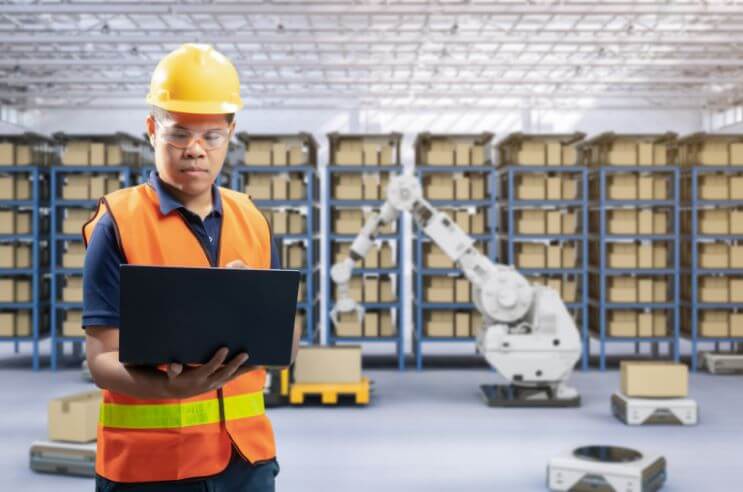
Source: www.canva.com
What is storage automation?
Warehouse automation and robotization is the process of implementing modern technologies within warehouses aimed at carrying out repetitive and time-consuming activities (receipt of goods, storage, shipping, etc.) with as little human assistance as possible. The goal is to streamline and optimize various tasks and processes within a warehouse environment.
Example: Picking products by hand from shelves for each order can be slow and there is a greater chance of an employee making a mistake. How can storage automation tools help?
- Pick-to-Light and Put-to-Light systems use lights and displays to guide warehouse workers when selecting items. Thanks to that, employees make fewer mistakes and process more shipments.
- Robotic arms can completely replace the manual task of picking items up. They can be programmed to handle various shapes, sizes, and weights of items with precision and speed. Utilizing robotic arms once again streamlines operations, bringing lower labor costs and the ability to work continuously.
Robotization and automation of warehouses are a necessity for businesses that want to maintain competitiveness. Customer demands for speedy order delivery are constantly escalating and companies must ensure they can meet these demands. One way to improve delivery times is through warehouse optimization which may involve the automation and robotization of warehouses.
Tip: Do you want to find out what other ways there are to improve your delivery time? Read the article: 90% of Customers Consider Two to Three-day Shipping Standard: 3 Ways to Improve Your Delivery Time.
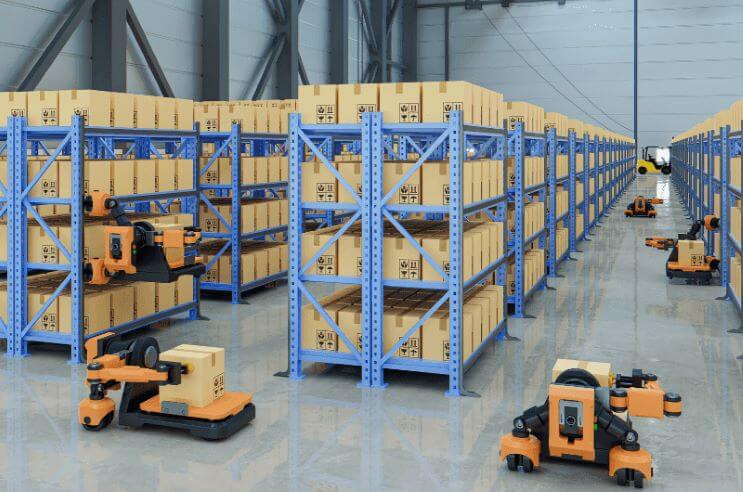
Source: www.canva.com
Benefits of robotics and automation in warehousing
The value of the global warehouse automation market in 2023 is US $23 billion. It is expected that the market will grow at a CAGR (compound annual growth rate) of roughly 15% in the upcoming years and reach a size of US $41 billion in 2027 (statista.com). For context, the global artificial intelligence (AI) market will reach a value of US $184 billion in 2024 with an expected annual growth rate (CAGR) of 28.46%, resulting in a market volume of US $826.70 billion by 2030 (statista.com).
The growing market value means that companies will invest more in warehouse automation and robotics. Why? Because it provides them with a range of benefits leading to warehouse optimization.
1. Improved accuracy
Did you know that receiving the incorrect item is the main reason given by customers (23%) for returning an item (elogii.com, 2020)? Delivery of the wrong goods not only costs companies additional expenses (returning the goods and subsequently delivering the correct item) but it can also cost them the trust of the customer.
What is the solution? Automatization: because automated systems are less prone to human error, order fulfillment, shipping, and inventory management procedures can be carried out with greater accuracy.
2. Cost savings
More precisely, long-term cost savings, because the initial costs of storage automation will be significant. However, in the long run, automation will bring cost savings to your company. Whether in the form of reduced labor costs, lower error rates, or optimized use of space and resources.
According to surveys, the use of robotics in the warehousing sector can help warehouses reduce average labor and manufacturing costs by 25 to 30% (meteorspace.com, 2022).
3. Enhanced safety
By taking on tasks that are dangerous, repetitive, or demanding for human workers, automation can help lower the risk of accidents and injuries at work.
One specific example of enhanced workplace safety through automation could be the use of robots to handle heavy or hazardous materials (chemicals, fuels, and others). By having these tasks performed by robots instead of humans, the risk of injuries associated with these activities is reduced.
4. Improved inventory management
A significant advantage of warehouse robotization and automation is improved inventory management. Automated systems enable:
- real-time monitoring
- optimization of storage
- automatic replenishment
- error reduction
- integration with ERP systems
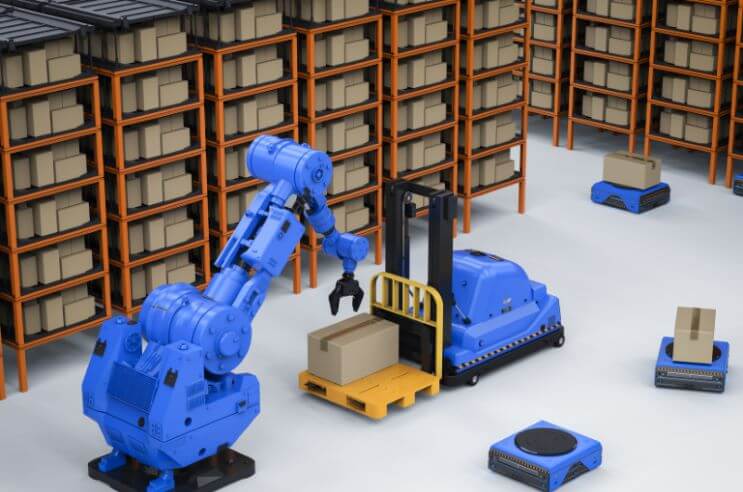
Source: www.canva.com
5. Fast scale-up
Consumer demand often changes, whether due to the season, economic conditions, or entirely different reasons. This change in demand also affects the entire warehouse operation. When demand for your products increases rapidly in your company, you will not only need larger storage spaces but also more employees.
However, acquiring new employees and expanding warehouses are all additional costs. Automated systems are designed to scale easily in response to fluctuations in demand, allowing companies to adapt their operations efficiently without incurring significant additional costs.
6. Increased efficiency
Automation can increase the effectiveness of your warehouse operations, which can save costs by reducing equipment idle time, expediting order fulfillment, and making optimal use of available storage space.
According to EasyPost, warehouse automation can lead to a 25% increase in productivity, a 20% gain in space usage, and a 30% improvement in stock use efficiency.
Tip: Do you know what else can increase efficiency and reduce your costs? The load planning software EasyCargo can by being easy to use, saving space and time, providing the best 3D visualization, and by saving you money. Try all of the features of the EasyCargo software for free.
Types of robotics and automation warehouse solutions
Let’s discover the most common types of robotics and automation technologies in warehouses.
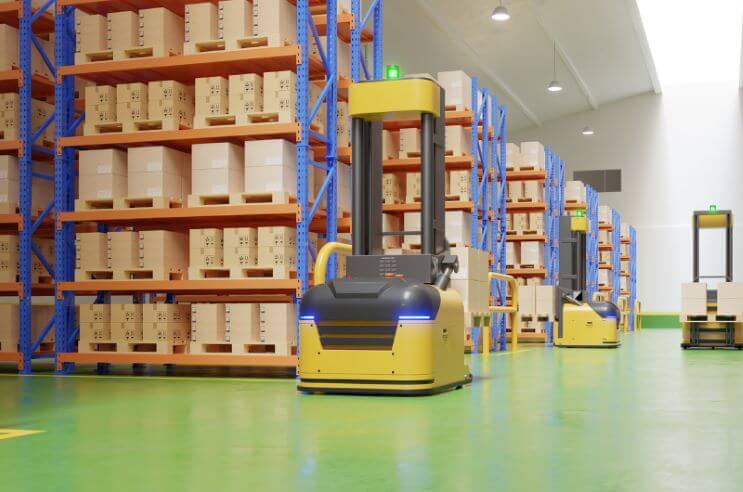
Source: www.canva.com
1. Automated Guided Vehicles (AGVs):
Warehouse workers who drive around the warehouse on forklifts and transport goods from one place to another are a thing of the past. In automated warehouses, they are replaced by mobile robots. They are often used for material handling tasks such as transporting pallets or containers.
The market for automated guided vehicles is projected to grow at a CAGR of 9.4% from 2024 to 2030, reaching US $9.18 billion (finance.yahoo.com, 2024).
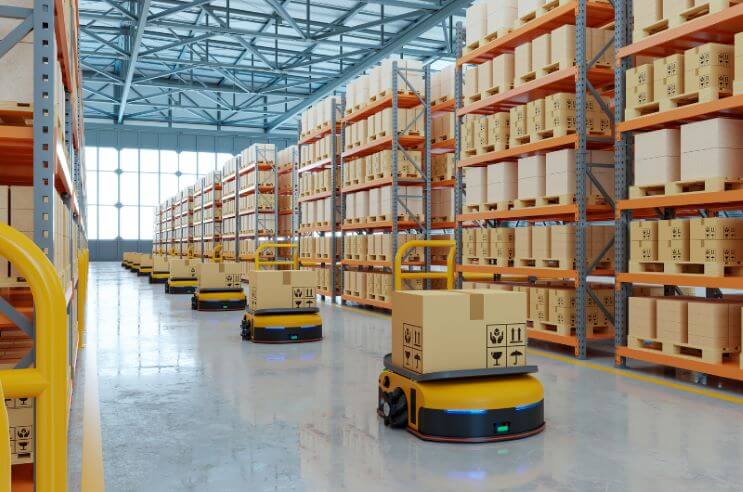
Source: www.canva.com
2. Autonomous Mobile Robots (AMRs)
AMRs are a more advanced version of AGVs. Like AGVs, they are mobile robots that move around the warehouse and transport goods, but unlike AGVs, they have several advantages. They are equipped with built-in sensors, cameras, and processors, allowing them to respond to changes in the environment (such as the movement of other employees in the warehouse) and navigate around obstacles. This means they can safely operate in the same environment as humans. Additionally, unlike AGVs, which have set paths, AMRs navigate autonomously, making them more flexible. Another advantage is that besides transporting items, they can also handle other tasks, such as packaging goods.
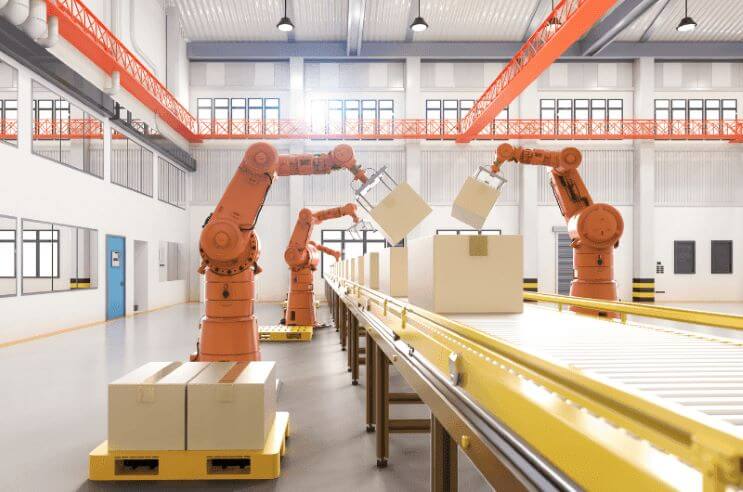
Source: www.canva.com
3. Robotic Arms
As the name suggests, robotic arms are mechanical devices that resemble human arms. Robotic arms can have a variety of attachments and are thus used for a wide range of tasks in the warehouse, such as packaging goods, palletizing, and handling. They are programmable and can be adapted to different shapes, sizes, and weights of objects.
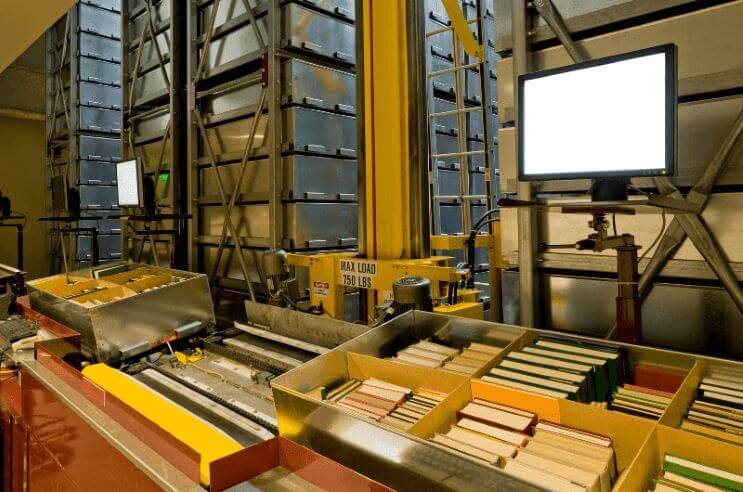
Source: www.canva.com
4. Automatic Storage and Retrieval Systems (AS/RS)
AS/RS systems handle the storage of products and their manipulation. These systems are designed to efficiently utilize warehouse space (products can be stored at greater heights than with manual handling) and minimize the need for human intervention in handling goods.
Automatic Storage and Retrieval Systems consist of tall racks and shelves equipped with automatic devices that move items between storage locations and picking stations. AS/RS systems can handle a wide variety of goods, from entire manufacturing assemblies to individual small products, such as electronic components, pharmaceutical products, and others.
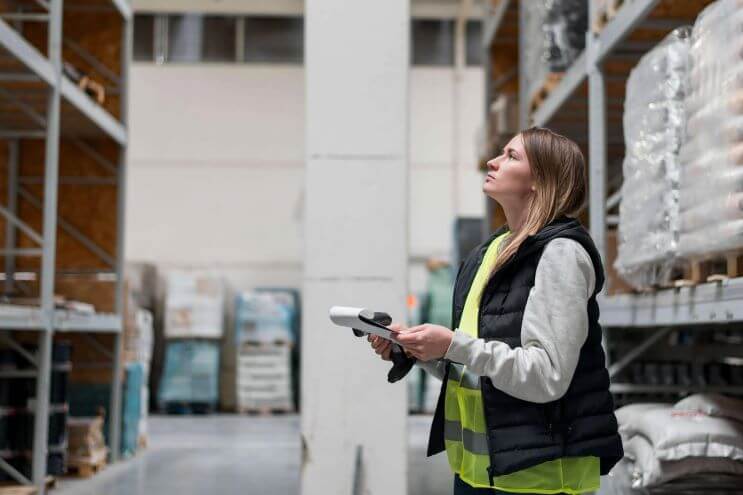
Source: www.canva.com
5. Pick-to-Light and Put-to-Light Systems
These systems use lights and displays to show warehouse workers which items to pick and where to place them. Lights shine above the appropriate item when it’s time to select it, making it simple for the employee to see. In a similar vein, lights show where an item should be stored when it’s time to take it down. Employees can pick and place objects more quickly and accurately with the aid of this visual guidance. The displays show how many products are left to pick or place, information on where exactly to place the selected items, or instructions for the next steps, such as confirming the pickup (depending on the type of system).
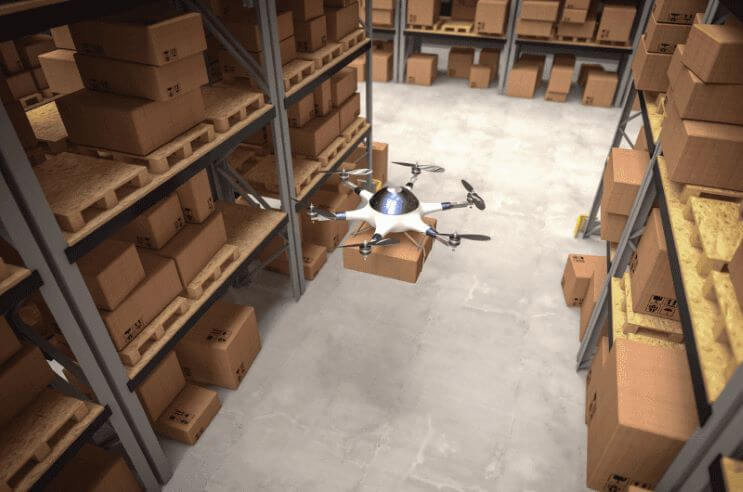
Source: www.canva.com
6. Drones
One option for warehouse automation is the use of drones. The main advantage of using drones is that they can easily access hard-to-reach areas within a warehouse, such as high shelves or narrow aisles, without the need for specialized equipment or additional safety measures.
Drones in warehouses have a wide range of uses such as:
- Easy Inventory: Drones can quickly and accurately perform inventories by flying through warehouse spaces and scanning barcodes.
- Stock Level Alerts: Drones first conduct an inventory, based on which they determine the exact quantity and type of goods in stock. For each type of goods, predefined thresholds can be set. If any goods fall below the specified quantity, drones can automatically send alerts if they detect that the warehouse is running low on some goods.
- Error Detection: Just as they can alert to stock shortages, they can also notify of misplaced items. Drones are connected to the Warehouse Management System, which allows them to compare the actual location of the product with the expected location.
Industry reports predict that drone use in warehouses will increase dramatically. For instance, according to Gartner, there will be over 13 million drones in use worldwide across industries by 2029, up from 989,000 in 2019. Drones can save a significant amount of time and money as well as being able to improve warehouse safety and operational efficiency, which is what is driving this growth.
Tip: Warehouses are not the only places in logistics where drones are utilized. Another use for them is in last-mile delivery. Check out the article about last-mile delivery to discover other innovations used in last-mile delivery.
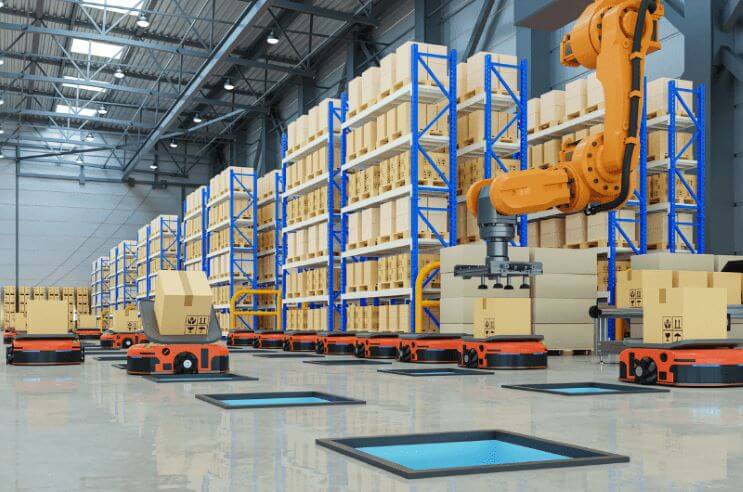
Source: www.canva.com
7. Automated Sortation Systems
Automated sortation systems sort and direct products to specific locations within the warehouse or distribution center. These systems utilize a combination of conveyors, sensors (barcode scanners, weight sensors, etc.), and software, which process data from sensors and communicate with the Warehouse Management System, to automatically sort items based on various criteria, such as size, weight, destination, or product type.
This is just a list of the most commonly used technologies for warehouse automation and robotics. However, the selection always depends on the specific needs of companies. Moreover, these individual technologies can be integrated within a Warehouse Management System (WMS). A WMS is a system that integrates all other systems and technologies used in the warehouse as well as manages individual activities within the warehouse. Furthermore, it ensures management and control of warehouse operations, such as receiving goods, stock storage, warehouse space planning, ordering, processing, and goods dispatch.
How can you implement solutions for automation and robotics in your warehouse?
By following these steps, you can implement automation and robotics solutions in your warehouse to streamline operations and improve efficiency.
Assess the current state and plan the next steps
The first step in warehouse automation is to determine the current state of your warehouse management. What exactly does that mean?
- Analyze current warehouse activities.
- Identify areas that need improvement.
Select suitable technology
After identifying activities that need improvement, the next step is selecting the appropriate technology. Consider criteria such as:
- Costs: Calculate the initial investment costs, as well as operational costs, maintenance costs, and implementation-related expenses.
- Implementation feasibility: Determine how quickly and easily you can implement the technology into your existing warehouse operations and how much the implementation will disrupt your warehouse operations.
- Technology flexibility: Remember that the chosen technology should be flexible enough to adapt to changes in the warehouse (expansions, new products, etc.).
- Efficiency: Consider how efficiently and accurately the technology will meet the warehouse’s requirements and how it will contribute to overall operational optimization.
- Compatibility: Ensure that the selected technology is compatible with existing systems and processes in the warehouse to facilitate the easy integration of new technologies into the existing infrastructure.
- ROI (return on investment): Calculate ROI to determine how long it will take for the investment in new technologies to pay off through savings or increased productivity. Below is the formula to calculate it:

Integrate new technology with existing systems
Make sure the new technology works with the warehouse’s current systems. You need to integrate it with the Warehouse Management System and other current systems with emerging automation and robotics technology.
Train the warehouse workers
Provide training for your employees so they learn how to work with the new technology. They should know not only how to operate it but also the safety measures, and what to do in case a problem arises.
Tip: Read what skills your warehouse keepers should have and tips on how to build them.
Monitor the results
By monitoring performance (we mean tracking the utilization and performance of equipment), identifying potential issues or deficiencies, and addressing them through maintenance or updates. By doing this, you ensure the efficiency and optimal operation of the warehouse.
It is also important to ensure regular improvements to systems to keep pace with new technological trends and fully leverage the potential of automation and robotics in the warehouse. By regular improvements, we don’t only mean software updates but also upgrades of older robots as well as automated systems with new versions and optimization of warehouse workflow.
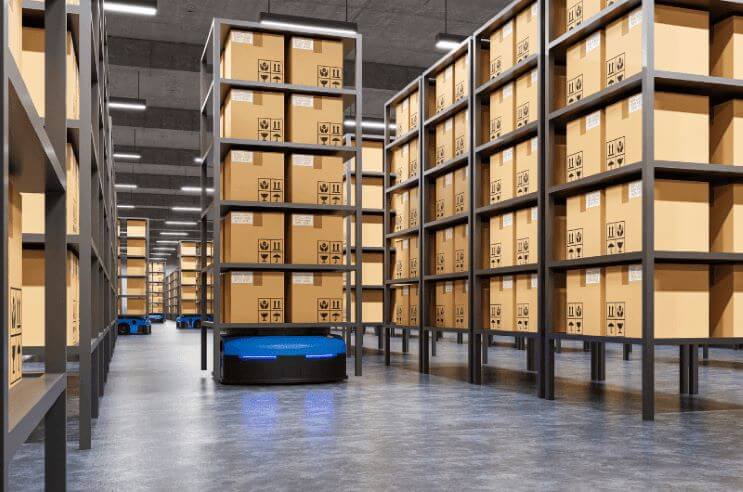
Source: www.canva.com
An example of robotic warehouse automation at Amazon
Amazon began its foray into warehouse robotics as early as 2012. However, the first fully automated warehouse was not launched until 2014. Since then, Amazon has continuously innovated and optimized robotics and automation in its warehouses. It owns a research and development center in Seattle, where a team of engineers and scientists works on creating and improving robots for warehouses.
Currently, Amazon has over 750,000 robots in its warehouses, compared to just 200,000 mobile robots in 2019. In 2023, Amazon implemented a new robotic solution called Sequoia. This system utilizes robotic arms for sorting parcels, gantry systems (systems to move objects or tools), and mobile shelving units. Amazon stated that Sequoia can reduce order fulfillment time by 25% as well as accelerate item identification and storage by 75%.
Automate step-by-step
To make your warehouse processes more efficient, you don’t need to automate the entire warehouse right away. To save space, time, and money, you can use the EasyCargo software. This application allows you to easily plan the loading of trucks, containers, and other spaces. Try EasyCargo for free and discover all of its features.




